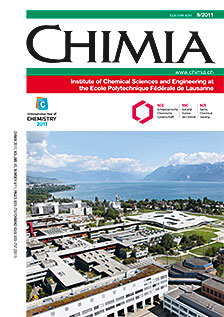Hydrogen Storage and Delivery: The Carbon Dioxide – Formic Acid Couple
DOI:
https://doi.org/10.2533/chimia.2011.663Keywords:
Co2 reduction, Formic acid, High-pressure h2 generation, Hydrogen storage, Iron catalysis, Ruthenium catalystAbstract
Carbon dioxide and the carbonates, the available natural C1 sources, can be easily hydrogenated into formic acid and formates in water; the rate of this reduction strongly depends on the pH of the solution. This reaction is catalysed by ruthenium(ii) pre-catalyst complexes with a large variety of water-soluble phosphine ligands; high conversions and turnover numbers have been realised. Although ruthenium(ii) is predominant in these reactions, the iron(ii) – tris[(2-diphenylphosphino)-ethyl]phosphine (PP3) complex is also active, showing a new perspective to use abundant and inexpensive iron-based compounds in the CO2 reduction. In the catalytic hydrogenation cycles the in situ formed metal hydride complexes play a key role, their structures with several other intermediates have been proven by multinuclear NMR spectroscopy. In the other hand safe and convenient hydrogen storage and supply is the fundamental question for the further development of the hydrogen economy; and carbon dioxide has been recognised to be a viable H2 vector. Formic acid - containing 4.4 weight % of H2, that is 53 g hydrogen per litre - is suitable for H2 storage; we have shown that in aqueous solutions it can be selectively decomposed into CO-free (CO < 10 ppm) CO2 and H2. The reaction takes place under mild experimental conditions and it is able to generate high pressure H2 (up to 600 bar). The cleavage of HCOOH is catalysed by several hydrophilic Ru(ii) phosphine complexes (meta-trisulfonated triphenylphosphine, mTPPTS, being the most efficient one), either in homogeneous systems or as immobilised catalysts. We have also shown that the iron(ii) – hydrido tris[(2-diphenylphosphino)ethyl]phosphine complex catalyses with an exceptionally high rate and efficiency (turnover frequency, TOF=9425 h?1mol?1; turnover number, TON=92400) the formic acid cleavage, in environmentally friendly propylene carbonate solution, opening the way to use cheap, non-noble metal based catalysts for this reaction, too.Downloads
Published
2011-09-30
Issue
Section
Scientific Articles
License
Copyright (c) 2011 Swiss Chemical Society

This work is licensed under a Creative Commons Attribution-NonCommercial 4.0 International License.
How to Cite
[1]
G. Laurenczy, Chimia 2011, 65, 663, DOI: 10.2533/chimia.2011.663.







